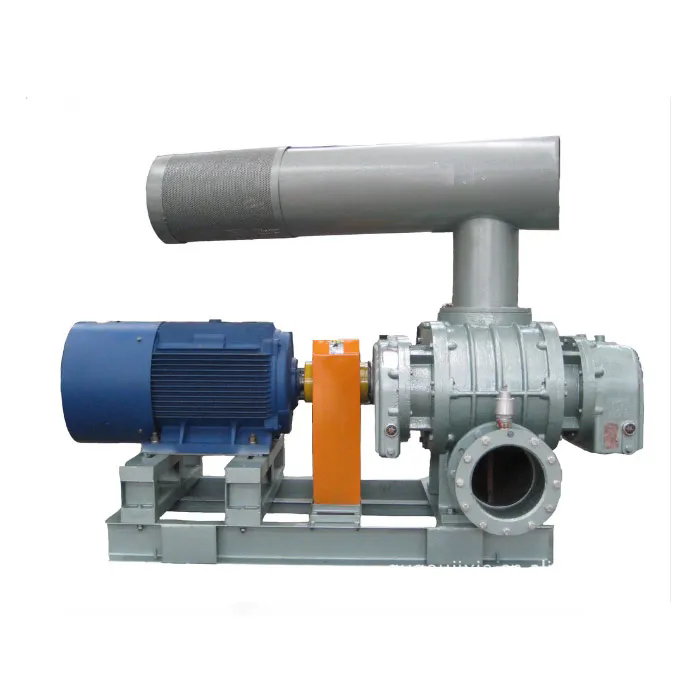Direct Drive Roots Blower: A Comprehensive Guide to Efficient Air Handling
2024-09-10
In the world of industrial and commercial air handling, the Direct Drive Roots Blower stands out as a highly efficient and reliable solution. Known for its robust performance and durability, the direct drive Roots blower is integral to many applications that require reliable airflow and pressure. In this blog, we’ll delve into what a direct drive Roots blower is, how it works, its advantages, and its various applications.
What Is a Direct Drive Roots Blower?
A Direct Drive Roots Blower is a type of positive displacement blower used to move air or gases in various industrial processes. The term "Roots blower" refers to the specific design of the blower, which uses two counter-rotating lobes or rotors to compress and move air. The "direct drive" aspect indicates that the blower is powered directly by an electric motor without the need for intermediate belts or gears.
This design is named after the Roots brothers, who patented the concept in the early 20th century. The direct drive mechanism offers several benefits, including increased efficiency, reduced maintenance, and improved reliability.
How Does a Direct Drive Roots Blower Work?
The operation of a direct drive Roots blower involves several key components and processes:
1. Rotors: The blower contains two rotors (or lobes) that are designed with a specific profile. These rotors are mounted on parallel shafts and rotate in opposite directions. As they turn, they create a moving chamber that traps air and moves it through the blower.
2. Compression: As the rotors rotate, they draw air into the inlet side of the blower. The trapped air is then compressed between the rotors and the housing. This compression occurs without significant contact between the rotors and the casing, which helps to minimize wear and tear.
3. Discharge: Once compressed, the air is expelled through the outlet side of the blower. The direct drive mechanism ensures that the air is moved efficiently and with minimal energy loss.
4. Motor: In a direct drive system, an electric motor is directly connected to the blower’s rotors. This direct connection eliminates the need for belts or gears, leading to a more compact and efficient design.
Advantages of Direct Drive Roots Blowers
Direct Drive Roots Blowers offer several advantages over other types of blowers and air-moving devices:
- High Efficiency: The direct drive mechanism reduces energy loss by eliminating the need for intermediate components like belts or gears. This results in higher overall efficiency and lower energy consumption.
- Reduced Maintenance: With fewer moving parts and no belts to replace, direct drive Roots blowers require less maintenance compared to traditional systems. This leads to lower operating costs and reduced downtime.
- Improved Reliability: The direct drive design minimizes the risk of mechanical failures and extends the lifespan of the blower. The absence of belts or gears means fewer points of potential failure.
- Compact Design: The direct drive system allows for a more compact and streamlined blower design. This can be beneficial in applications where space is limited.
- Quiet Operation: The direct drive mechanism often results in quieter operation compared to gear-driven systems, making it ideal for applications where noise reduction is important.
- Consistent Performance: Direct drive Roots blowers provide stable and consistent airflow, making them suitable for applications that require precise and reliable air handling.
Applications of Direct Drive Roots Blowers
Direct drive Roots blowers are versatile and used in a variety of industries and applications:
- Industrial Processes: They are commonly used in industrial applications such as pneumatic conveying, aeration in wastewater treatment, and material handling. Their ability to handle large volumes of air makes them suitable for these demanding processes.
- HVAC Systems: In heating, ventilation, and air conditioning (HVAC) systems, direct drive Roots blowers help improve air circulation and maintain desired indoor air quality.
- Automotive Industry: They are used in automotive applications for boosting and supercharging engines, providing improved performance and efficiency.
- Food and Beverage Industry: In food processing and packaging, direct drive Roots blowers are used to ensure consistent airflow and prevent contamination.
- Chemical and Pharmaceutical Industries: They play a role in providing controlled
atmospheres for various chemical reactions and processes, ensuring safety and precision.
- Mining and Agriculture: Direct drive Roots blowers are used in pneumatic transport systems for moving materials and in agricultural processes to aid in the aeration of soil and compost.
Maintenance and Care
To ensure optimal performance and longevity of a direct drive Roots blower, regular maintenance is crucial:
- Routine Inspections: Regularly check for signs of wear, such as unusual noises or vibrations. Ensure that the blower’s components are in good condition and that there are no leaks.
- Lubrication: Depending on the model, some components may require periodic lubrication to function smoothly. Follow the manufacturer’s recommendations for lubrication intervals and types.
- Filter Maintenance: If the blower is equipped with air filters, they should be inspected and cleaned or replaced as needed to maintain airflow efficiency.
- Cooling: Ensure that the blower is properly ventilated and cooled, as overheating can affect performance and cause damage.
Future Trends in Direct Drive Roots Blowers
The technology behind direct drive Roots blowers continues to evolve, with several trends shaping the future:
- Energy Efficiency: Advances in motor technology and blower design aim to further enhance energy efficiency, reducing operational costs and environmental impact.
- Smart Technology: Integration with smart technology and IoT (Internet of Things) can provide real-time monitoring and diagnostics, allowing for predictive maintenance and improved system management.
- Materials and Design: New materials and design innovations may lead to even more durable and lightweight blowers, enhancing performance and ease of installation.
- Noise Reduction: Continued efforts to reduce noise levels will make direct drive Roots blowers even more suitable for applications where noise control is critical.
Conclusion
The Direct Drive Roots Blower is a powerful and efficient solution for various air handling needs. Its robust design, high efficiency, and low maintenance requirements make it a preferred choice for many industrial and commercial applications. By understanding its operation, benefits, and potential applications, you can better appreciate how this essential piece of equipment contributes to optimized performance and reliability in air-moving processes. As technology advances, direct drive Roots blowers will continue to play a crucial role in shaping the future of air handling and industrial processes.



